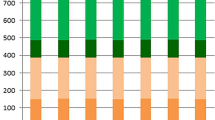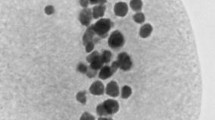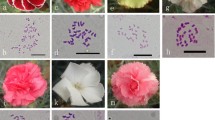Abstract
Interspecific hybrid plants between Melilotus altissima (yellow flowers) and either M. alba (white flowers) or M. taurica (white flowers) and between M. suaveolens (yellow flowers) and M. wolgica (white flowers) which were inviable because of heavy chlorosis, were grown successfully by in vitro culture and reached the flowering stage. Pollen fertility of hybrid plants between M. altissima and M. alba was about 46% whereas hybrids between M. altissima and M. taurica and between M. suaveolens and M. wolgica showed about 25% and 18% of pollen fertility, respectively. All F1s did not set any selfed seeds. Observing the pairing of chromosomes at metaphase I in the hybrid plants, it was revealed that the genomes of M. altissima and M. alba differ by a reciprocal translocation. This result could account for the partial sterility of pollen in the F1 hybrids. On the other hand, hybrid plants between M. altissima and M. taurica and between M. suaveolens and M. wolgica showed normal pairing of chromosomes though pollen fertility of the hybrids was very low, suggesting that low pollen fertility was controlled by sterility gene(s). These results demonstrate that M. altissima and 7 other species of the subgenus Eumelilotus share the same chromosomal constitution. The only exception, M. alba, differs from the other 8 species by a segmental interchange.
Similar content being viewed by others
References
Grant, V., 1956. Chromosome repatterning and adaptation. Adv Genet 8: 89-107.
Grant, V., 1966. Block inheritance of viability genes in plant species. Amer Nat 100: 591-601.
Grant, V., 1967. Linkage between morphology and viability in plant species. Amer Nat 101: 125-139.
King, M., 1993. Species evolution. The role of chromosome change. Cambridge University Press, Cambridge.
Maekawa, M., Hasen & F. Kita, 1991. Identification of reciprocal translocations observed in several Melilotusspecies (subgenus Eumelilotus) by interspecific triple crossings. Euphytica 54: 255- 261.
Marubashi, W., T. Manabe, N. Nakamura & Y. Onozawa, 1987. Overcoming hybrid lethality between Nicotiana tabacumL. and N. suaveolensLehm.. Japan J Breed 37 (Suppl 2): 116-117.
Sano, Y. & F. Kita, 1975. Cytological studies of several interspecific F1 hybrids in the subgenus Eumelilotus. J FacAgr Hokkaido Univ 58: 225-246.
Sano, Y. & F. Kita, 1978a. Reproductive barriers distributed in Melilotusspecies and their genetic bases. Canad J Genet Cytol 20: 275-289.
Sano, Y. & F. Kita, 1978b. Genes for reproductive isolation located on rearranged chromosomes. Heredity 41: 377-383.
Schlarbaum, S.E., J.B. Johnson, H.J. Gorz & F.A. Haskins. 1984 Identification of chromosomes with secondary constructions in Melilotusspecies. J. Hered. 75: 23-26.
Smith, W.K., 1943. Propagation of chlorophyll-deficient sweetclover hybrids as grafts. J Hered 34: 135-140.
Stevenson, G.A., 1969. An agronomic and taxonomic review of the genus MelilotusMill. Can J Plant Sci 49: 1-20.
White, P.R., 1963. The cultivation of animal and plant cells, 2nd edition. Ronald Press, New York.
Author information
Authors and Affiliations
Rights and permissions
About this article
Cite this article
Ha, S., Maekawa, M., Kita, F. et al. Cytological relationships among Eumelilotus species analysed using cytological observations of interspecific hybrids obtained by in vitro culture. Euphytica 101, 17–22 (1998). https://doi.org/10.1023/A:1018310824686
Issue Date:
DOI: https://doi.org/10.1023/A:1018310824686




